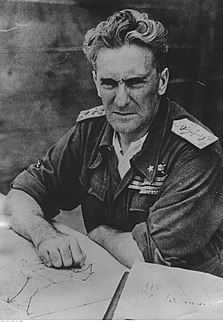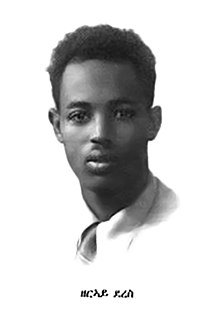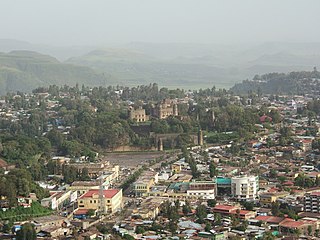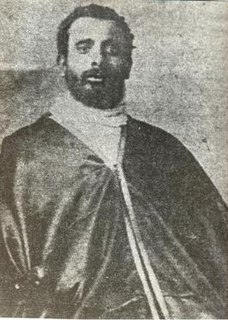
Marshal Rodolfo Graziani, 1st Marquis of Neghelli, was a prominent Italian military officer in the Kingdom of Italy's Regio Esercito, primarily noted for his campaigns in Africa before and during World War II. A dedicated fascist, he was a key figure in the Italian military during the reign of Victor Emmanuel III.

Brigadier-General Mengistu Neway was the commander of the Ethiopian Imperial Guard during the reign of Emperor Haile Selassie. He is noted for being one of the early dissidents of the Emperor's regime and for organizing the 1960 coup attempt with his younger brother Germame Neway.

The Second Battle of Tembien was a battle fought on the northern front of what was known as the Second Italo-Abyssinian War. This battle consisted of attacks by Italian forces under Marshal Pietro Badoglio on Ethiopian forces under Ras Kassa Haile Darge and Ras Seyoum Mangasha. This battle was primarily fought in the area around the Tembien Province. The Ethiopeans were decisively defeated, and their armies destroyed as effective fighting forces in the rout. The battle is notable for the Italian aerial supremacy and for their largescale use of mustard gas.

The Battle of Shire was a battle fought on the northern front of what was known as the Second Italo-Abyssinian War. This battle consisted of attacks and counterattacks by Italian forces under Marshal of Italy Pietro Badoglio and Ethiopian forces under Ras Imru Haile Selassie. This battle was primarily fought in the Shire area of Ethiopia.

The March of the Iron Will, or the Iron-Will Column, was a Fascist propaganda event staged during the final days of the Second Italo-Ethiopian War. The goal of the march was to capture the Ethiopian capital in a show of force.
De Bono's invasion of Abyssinia took place during the opening stages of the Second Italo-Abyssinian War. Italian General Emilio De Bono invaded northern Abyssinia from staging areas in the Italian colony of Eritrea on what was known as the "northern front."
Wondosson Kassa, also known as Wond Wossen Kassa, was a member of the royalty of the Ethiopian Empire, an army commander, and a patriot.
Aberra Kassa was an army commander and a member of the Royal family of the Ethiopian Empire.
Asfawossen Kassa was an army commander and a member of the Royal family of the Ethiopian Empire.

Zerai Deres was an Eritrean translator and patriot. In 1938, he engaged in an act of public devotion to an important symbol of his native country, the Monument to the Lion of Judah, at the time kept in Rome. When interrupted, he violently protested against Italian colonialism while brandishing a scimitar, which led to his arrest and internment in a psychiatric hospital for seven years, until his death. However, contemporary Italian historians doubt the claim that he was mentally unstable. Zerai's protest, lionized after the end of the Second World War, is considered by Eritrean and Ethiopian historiography as part of the movement against Italian occupation. To this day, Zerai is considered a legend and a folk hero of anticolonialism and antifascism both in Eritrea and Ethiopia.
The Black Lions were a anti-fascist resistance movement formed to fight against Italy during the occupation of the Ethiopian Empire in the Second World War.
Yekatit 12 is a date in the Ethiopian calendar, equivalent to 19 February in the Gregorian calendar, which is commonly used to refer to the indiscriminate massacre, known as the Addis Ababa massacre, and imprisonment of Ethiopians by elements of the Italian occupation forces following an attempted assassination of Marshal Rodolfo Graziani, Marchese di Neghelli, Viceroy of Italian East Africa, on 19 February 1937. Marshal Graziani had led the Italian forces to victory over their Ethiopian opponents in the Second Italian invasion of Ethiopia and was supreme governor of Italian East Africa. This was one of the worst atrocities committed by the Italian occupation forces and has been described as the worst massacre in Ethiopian history.

Italians of Ethiopia are the immigrants from Italy who moved to live in Ethiopia as far back as the 19th century, and their descendants. King Menelik II did not allow the sale of lands belonging to Ethiopia to Italians (Eritrea) and probably allowed France (Djibouti) to solidify his centralized power and have external trading partners. Most of the Italians moved to Ethiopia after the Italian conquest of Abyssinia in 1936. Italian Ethiopia was made of Harrar, Galla-Sidamo, Amhara and Scioa Governorates in summer 1936 and became a part of the Italian colony Italian East Africa, with capital Addis Abeba and with Victor Emmanuel III proclaiming himself Emperor of Ethiopia.

Italian Ethiopia was a short-lived enterprise to create a colony of the Kingdom of Italy located in East Africa, on the territory of Ethiopia. It was proclaimed in 1936 following the second Italo-Ethiopian War in which the Ethiopian Empire was occupied by Benito Mussolini's Fascist Italy. It became part of Italian East Africa, with its capital moved to Addis Ababa and Victor Emmanuel III proclaiming himself Emperor of Ethiopia.
The following is a timeline of the history of the city of Addis Ababa, Oromia Region, Ethiopia.
Alem Bekagn, also known as Akaki Prison or Kerchele Prison, was Ethiopia's central prison until 2004. Located in Addis Ababa, the prison possibly existed as early as 1923, under the reign of Empress Zewditu, but became notorious after Second Italo-Ethiopian War as the site where Ethiopian intellectuals were detained and killed by Italian Fascists in the Yekatit 12 massacre. After the restoration of Emperor Haile Selassie, the prison remained in use to house Eritrean nationalists and those involved in the Woyane rebellion. Under the Communist Derg regime that followed, the prison was the site of another mass killing, the Massacre of the Sixty, and of the torture and execution of rival groups in the Red Terror. The prison remained a site of human rights abuses until the Ethiopian People’s Revolutionary Democratic Front entered Addis Ababa on 28 May 1991, after which it became a normal prison. The prison was closed in 2004 and demolished in 2007 to allow the construction of the headquarters of the African Union.















